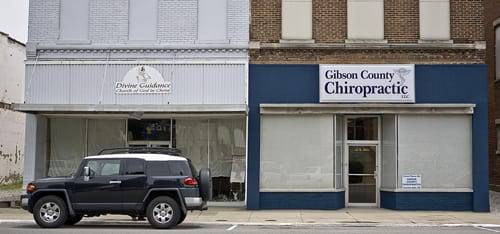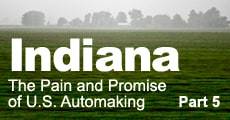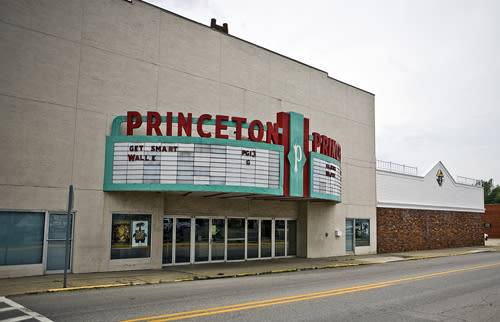Princeton: Toyota Marks 10 Years in Midwest

By Eamonn Brennan
Cars.com

“They are the type of community partner you can only dream of,” said Todd Mosby, executive director of the Gibson County Economic Development Corporation.
Before that dream became reality, Toyota had to settle its new neighbors’ concerns: How many of the plant’s 1,300 employees would come from Gibson County? Would the relaxed lifestyle in Princeton be forced to speed up? Would local property taxes explode? How much would employees be paid?

“There were some that were very excited,” Greg Harden, a team leader at Princeton’s Toyota Motor Manufacturing Indiana plant since 1998, said of local residents. “Others wanted to wait and see.”
Ten years later, those questions have largely been answered, and Princeton’s qualms have been quieted — but they have not entirely vanished.
Laying Down Roots
In southwest Indiana, residents have built things with their hands for decades. That legacy continues today. Bristol-Myers Squibb, Alcoa, Whirlpool and General Electric collectively employ about 10,000 people in Evansville and the surrounding area. Gibson Generating Station in Owensville is the world’s third-largest coal power plant, and a mine operated by Gibson County Coal produces 5 million tons of coal a year. Far from the post-industrial loss of jobs other parts of Indiana have experienced, blue-collar work continues to thrive in the area.
This was the environment where Toyota — after a lengthy courtship with state and local leaders — chose to zero in on the already-skilled work force and the region’s cheap energy and close proximity to transportation and suppliers. The plant opened in 1998 with 1,300 employees building Tundra pickups. After billions more in investment — Toyota says almost $3.6 billion as of December 2007 — the automaker now builds Tundras, Sequoia SUVs and Sienna minivans at the plant, at a capacity of 350,000 autos per year. Today, 4,700 employees work at the plant.
And they’re well-paid for it. According to the Indiana Business Research Center, in 2004, the average salary for Gibson County residents hit $42,091, up a whopping 66 percent from the $25,410 average back in 1994.
“There’s no question we’ve grown,” Harden said. “And as we’ve grown the plant has been allowed to give back more and more to the community.”
Giving and Taking
Toyota has indeed made its monetary presence felt in Princeton. Mayor Bob Hurst estimated that Toyota has given $11 million over the decade it’s been in town, money that’s gone to local school programs, road improvements and revitalization efforts. In early 2009, Toyota will open a sprawling 16,000-square-foot visitor center at the plant that will include a theater, tours of the facility and a historical exhibit of Toyota’s manufacturing practices. Additionally, Toyota helped Princeton build a gazebo in front of its scenic brown-brick courthouse, a first step in the town’s effort to reinvigorate its long-dormant center.
“In most Indiana towns, the downtown area has died,” Hurst said. “We’re trying to bring that back.”
It’s a slow process; Princeton still has a sleepy downtown, with some boarded-up storefronts but newly installed sidewalks running south down Main Street from the town’s square. Meanwhile, the town is expanding on its western fringe, which has become a hotbed of restaurants and stores, including a Super Wal-Mart and other national chains.
All this development can be a double-edged sword. While it brings more jobs and tax revenue to Princeton and Gibson County, it upsets some small-business owners, including Bob Dixon, owner of Pood’s bar on the south side of Princeton.
“What’s changed is the lack of employees,” Dixon said. “Toyota takes the cream of the crop of employees, and it’s hard to find good workers. It’s harder and harder for the little guy in business, especially my business — I can’t compete against chains [that use] national advertising.”
Taxing
The influx of chain businesses isn’t the only concern for some Princeton residents. While Toyota receives near-universal praise in town for its philanthropic side, some worry about higher property taxes and how they can keep up with the sense of prosperity that Toyota has helped create.
“My taxes certainly feel higher,” said Jeremy Robb, a Princeton police officer and auto mechanic. “People here think everyone makes Toyota money. I don’t make Toyota money.”
Toyota received the usual state and local incentives to build in Princeton, including a long-standing tax abatement that helps keep the plant’s operating costs low. Hurst confirmed that one of Toyota’s abatements is about to end, and the manufacturer’s tax revenues should begin to slowly increase this year. Many residents seem ready for that to happen.
“Toyota does a lot of good things for the community,” Dixon said. “But when you’re not paying taxes, it’s easier.”
Keep the Car Running
Toyota has avoided shutdowns and layoffs for most of the Princeton plant’s life, but one thing the models it builds there — Tundra pickups, Sequoia SUVs and Sienna minivans — have in common is that they’re gas-guzzlers. Though the three models sold well through the first quarter of 2008 — the Tundra even saw a surprising uptick in spring sales, according to the Wall Street Journal — the soaring cost of gas and the slump in SUV and truck sales has led Toyota to make changes in Princeton. The lines that produce Tundras and Sequoias will shut down for three months, beginning in August, and Tundra production will move to Toyota’s San Antonio plant. The Highlander SUV is scheduled to replace the Tundra in Princeton beginning in 2009. Workers in Princeton will not lose their jobs, Toyota says; instead, they’ll get training during those three months.
“It’s slow,” Toyota spokesman Mike Goss said, citing the dismal market for new-car sales in the U.S. “But Toyota has done its best to avoid laying employees off despite the slowdown.”
If current trends continue, could the Princeton plant eventually switch to building fuel-efficient Priuses or Camrys?
“Certainly Toyota understands it has to be flexible in this ever-changing environment,” plant spokesman Kelly Dillon said. “Every plant has a certain amount of flexibility.”
Toyota and Princeton Lean on One Another
Despite the uncertainty and tax worries, the relationship between Princeton and Toyota seems to be a healthy one. Not only has the plant expanded jobs and created wealth — Gibson County ranks No. 150 in the nation in average individual income — Toyota’s philanthropy has clearly impressed the small town.
And they’ve done it, as Mosby said, without becoming the “200-pound gorilla in the room.” Toyota has quietly changed the face of Princeton, but not too much, he said.
“Over the past 10 years, if anything we weren’t prepared for what could be,” Mosby said. “Now we’re thinking, in the next 10, where do we want to be?”
Indiana: The Pain and Promise of U.S. Automaking Part 1
Indiana: The Pain and Promise of U.S. Automaking Part 2
Indiana: The Pain and Promise of U.S. Automaking Part 3
Indiana: The Pain and Promise of U.S. Automaking Part 4
Princeton, Indiana in Pictures
Featured stories

15-Year Car Loans Aren’t a Thing, But Americans Are Getting More Comfortable With Long Loan Terms

2025 Kia Telluride Review: Rougher Roads Ahead



